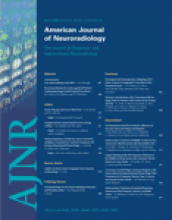Abstract
BACKGROUND AND PURPOSE: The ability to assess tumor malignancy and monitor treatment response noninvasively would be of value to both clinicians and animal investigators. This report describes the MR imaging characteristics of a genetically engineered mouse model of choroid plexus carcinoma (CPC) during tumor growth and progression to malignancy. We assess the ability of vessel tortuosity measurements, as calculated from high-resolution MR angiographic (MRA) images, to detect emerging CPC cancers.
METHODS: MR images of 9 healthy mice and of 20 CPC mice with precancerous choroid dysplasia or with cancer over a wide range of sizes were analyzed. Two vessel tortuosity measures and a measure of vessel attenuation (vessel count) were calculated from MRA images. Malignancy assessment was based upon a statistical analysis of vessel tortuosity, by using an equation derived from an earlier study of human brain tumor patients.
RESULTS: Choroid dysplasia was correctly judged nonmalignant. On the basis of vessel count, neoangiogenesis could not be detected until cancers were full-blown and had reached a volume of approximately 80 mm3. Vessel tortuosity measurements, however, correctly identified emerging malignancy in lesions larger than 0.3 mm3.
CONCLUSION: To the best of our knowledge, this report provides the first description of in vivo, MR imaging characteristics of genetically engineered CPC mice during the progression from dysplasia to cancer. Vessel tortuosity measurements offer promise of correctly defining even tiny tumors as malignant.
- Copyright © American Society of Neuroradiology












